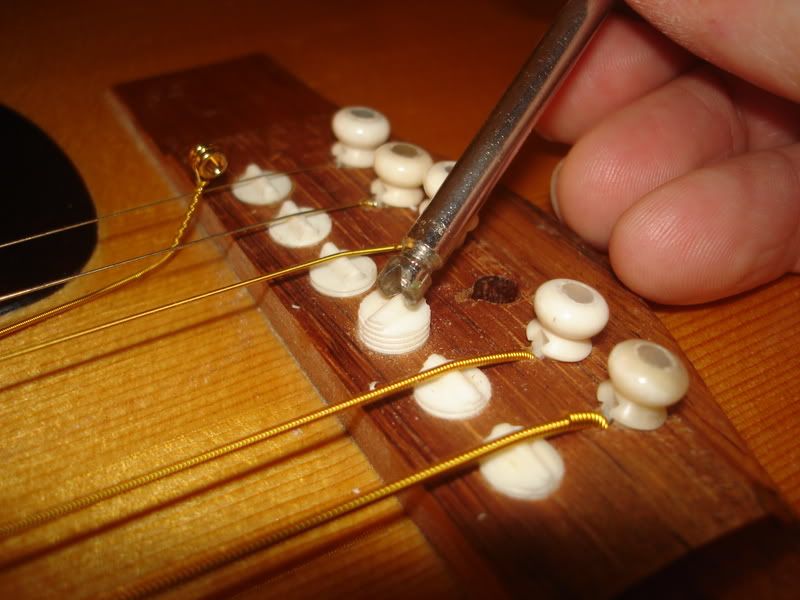Hey Guys,
Newbie here. I own a Early 70's Goya GG-174 with the individual saddles bridge. The guitar appears to now need a neck reset along with the bridge replacement.
I was just wondering if anyone has ever worked on one of these?
Views: 2359
Replies to This Discussion
-
I just finished one a couple months ago. Neck reset and bridge work. I worked with the original bridge because that's what the customer wanted, but if it were my guitar I'd replace the whole bridge with a proper belly-bridge and bone saddle, the adjustable plastic aren't a great idea. The neck comes off easily though, there's usually a hole through the neck block that allows access to the pocket. Still, it's not a job to be undertaken lightly.
-
I did new brass individual saddles on a Levin years ago. Try to send a pic. also if bad quality.
- Attachments:
-
Hi, How much did the brass saddles change the tone from the nylon ones? My nylon saddles still work, but I have considered replacing them as I think they must lose some of the tone. Brass rod and a 0.75 die seems easier than bone. What length did you make the studs? I had thought I might have to drill out some of the mass to avoid adding too much weight to the bridge, but perhaps the weight improves the bridge? In fact I have now replaced the brass bridge pins with rosewood.
-
I have done plenty.
Most of the 174:s are actually bolt-on necks, this was in the transition back to dovetail on the flattops in the Levin company. I have only seen a few dovetailed 174:s. Check if there are two bolts visible on the inside of the neckblock. The nuts have squareshaped holes which can be losened with a phillips tip screwdriver, try size 1 or 2. The only glue is under the fretboard.
Regarding the saddlescrews I´ve always found them to be a to-nice-to-remove feature, as it allows easy action adjustment, individually per string. I have made a few sets out of bone which works very well but they are difficult to make.
I like Antonios suggestion to make them in brass, which is something I have thought of trying. The thread type is M8x0.75, which is a "fine-thread" raising 0.75 mm per turn. Allows a minimum adjustment of 0.375 mm for a half lap which is pretty good as it adjust one half of that at 12th fret.
Personally I think it would be a mistake to change to another shape of bridge. This was the shape Levin used from 1967 until the end around 1980, it´s how this guitar shall look. And it is a belly bridge isn´t it, only a belly in better shape...;-)
I had one where the bridge was in pieces, where I made a new one with drop in saddle, which work fine to, but I miss the adjustability.
Pictures:
change to drop-in:

Bone-screws:






-
Here is a picture of the lower nut on the inside of the neckblock

-
Hi Magnus
Beautiful work.
I came across this old thread as I have been looking for a solution with my Levin W30 with adjustable plastic plugs as pictured.
Do you still have tools to manufacture new bone saddlescrews?
If so I would happily pay for your work, postage etc.
Best
Jesper, Copenhagen
-
Hi there. It's funny to be here again after a long hiatus! Sorry that I haven't answered to Eric Sharp about his questions, but you know... some things went lost along the time.
I preferred to make the saddles in brass because I was afraid that bone should have been too susceptible to breakage. Having made the studs about 10 or 12 mm in length (can't remember exactly), the weight wasn't too much to affect the tone (surely better than nylon!) and didn't need to be drilled to reduce its mass. Magnus considerations are perfect.
That old Levin is still arouud ad played by the niece of the original owner.
-
Hi Antonio
Giving you still have the tools, would you consider making 6 studs for my Levin?
I will pay for your trouble and expenses.
Best
Jesper, Copenhagen
-
Sorry Jasper, I did that work almost twenty years ago and I don't have the tools and material anymore.
Add to this that is not a good idea to do the job without having the guitar in the hands of the repair person. The risk is that if something go wrong you loose money and I loose time uselessly. But you can find a good lathe operator in your town to copy the nylon studs in brass or maybe bronze.
Good luck and let us know.
-
Thanks for your reply.
Good point, I will take the guitar to a luthier here in Copenhagen :-)
© 2025 Created by Frank Ford.
Powered by
![]()